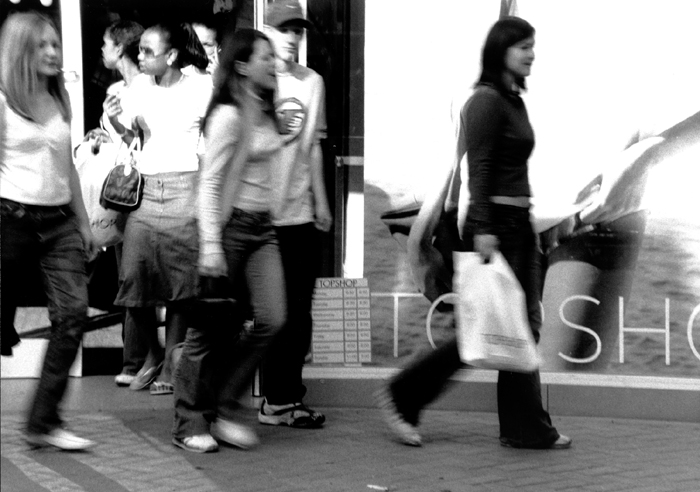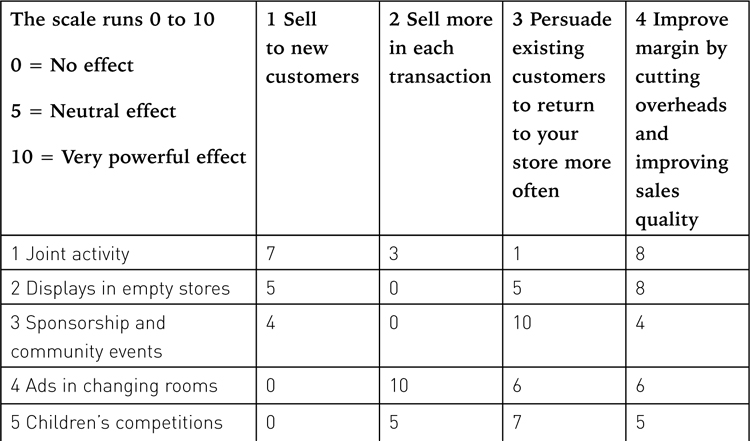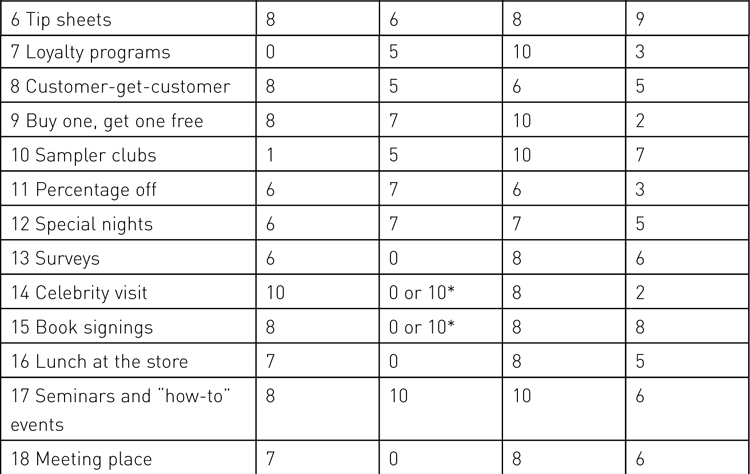Chapter Eleven. Promote or die
Carefully considered promotions are important because they create interest and surprise, and in conjunction with honest pricing and added value, are essential performance improvement tools. There are of course those other factors we’ve talked about to consider—promotions in isolation from great customer experiences or attention to employee needs are near worthless. Poor, aggressive, or sneaky promotions may bolster sales short-term but unhappy customers will rarely come back (breaking Rule 3 of the four rules of performance improvement in Chapter 9—Persuade existing customers to return to your store more often) and will tell friends how awful you are (breaks Rule 1—Sell to new customers). Unhappy employees will leave (that has a cost to you, so breaks Rule 4—Improve margin by cutting overheads and improving sales quality) or will not make any active selling efforts (breaking Rule 2—Sell more in each transaction).
28 promotions
Here I have listed most of the popular promotion options. I’ve included a table that makes it easy to see which promotions are good for achieving better performance under each of the four improvement rules. Finally, the promotions planner that follows after will help you to see what promotions are right for you and when to run them.
1—Joint activity
Look for promotions you can share with either manufacturers or other retailers in your street. The obvious benefit is that you can pool costs and then afford to promote the activity more aggressively. An example of retailers engaging in joint activity might be a “fun day” held within your shopping center. A manufacturer and retailer joint activity could include manufacturer-supplied demonstrators, linked to a customer promotion and a manufacturer-funded staff incentive.

So long as they walk out with a bag!
Source: Koworld
2—Displays in empty stores
I need to credit brilliant retail speaker Rick Segel with this great idea: Find the landlords of an empty local retail unit and offer to put a display in the window. It makes the unit look more appealing for the landlord to rent and provides you with an excellent adising space. I first mentioned this in 2003 when it was super-rare—you see it a lot now and it seems to work well for everyone involved.
3—Sponsorship and community events
Don’t dismiss requests for sponsorship right out of hand. Sometimes a sensible sponsorship can do more for you than, say, your Yellow Pages ad. Businesses located at the center of smaller communities gain most benefit from this form of promotion. Sponsoring events such as the town fun run or village fete makes a very strong statement about your commitment to the community. Many retailers have reported that the goodwill this creates does translate into sales.
4—Ads in changing rooms
Cheap, easy, and brilliant: put ads in your changing rooms. Your customer is absolutely captive when they are in there and they have plenty of time to read. Think about featuring deals on accessories especially—customers who bite will be helping to push up your average transaction values.
5—Children’s competitions
Maybe we are just a nation of soppy souls but children’s competitions always work well. These can be very simple coloring competitions or letter writing. Perhaps themed “draw or write a letter about your Mom for Mother’s Day.” Local papers love this sort of thing. You have a good chance of getting a photo printed in the paper of the winner in your store.
6—Tip sheets
No matter what your product you can easily produce useful tip sheets. A sheet of tips might seem a little uninspiring perhaps, but time and again retailers tell me that customers go nuts for these, often citing the tip sheets as the reason why customers come back. You can write tip sheets yourself or have a well-known expert do them for you at a cost. Formats can be anything from a full-color booklet to a small card fixed to a shelf edge. My favorite format is loose A5 so that customers can take the tip sheets away with them. Here are some forms of tip sheets:
• Recipes in a grocery store
• Recommendations and explanations in a wine merchant’s
• Hi-fi reviews in an electrical retailer
• Home projects in a DIY store
• Album reviews in a music shop
7—Loyalty programs
I don’t believe that customers are ever loyal to the over-hyped special offers, magazines, or bits of tinsel that most loyalty programs consist of. In my wallet is a Nectar Card, a Tesco Club Card, and an HMV Card. However, I’ll happily spend money in Asda, buy songs from iTunes, or get a quart of milk from Mehmet’s round the corner. I’m not loyal even though I am in the loyalty program. Neither am I alone in that response, but then, I think most of us understand that those schemes are really about data for benefits and we use them accordingly.
The kind of loyalty programs that work in more immediate ways are usually much simpler. Maybe a coffee shop gives you a little card that they stamp each time you visit, and that entitles you to your sixth coffee free. Or a pizza company offers a loyalty bonus that allows you to get any pizza you want for free if you have saved up four receipts from previous orders. Those kind of loyalty programs are unobtrusive and relatively low-cost and customers really like them.
8—Customer-get-customer
You could offer existing customers a gift, store coupons perhaps, if they recommend your store to a friend who then makes a purchase. All you need is a printed coupon, which you give to every customer with their receipt. The customer can fill in this coupon and give it to their friend. The friend brings in the coupon and it has the original customer’s details still written on it so you can send them their reward.
If you are confident that people like you enough to recommend your store to friends, this is an effective way in which to make it easy for them to do exactly that.
9—Buy one, get one free (or two-for-one, three-for-two, etc.)
In the early 2000s, this was the UK’s most popular promotional mechanic. If you can afford to run them, run them. Promote such offers heavily. Talk to your suppliers about funding either the offer, the advertising or both! If you can run a steady stream of good offers over a long period then this becomes even more effective because customers begin to pop in just to see what you’ve got on “special.”
10—Sampler clubs
In some ways, this is an extension of the tip sheet idea but with a chance for customers to actually try the product out. You take a group of your customers and sign them up to a hands-on sampling club. In that hi-fi store example, you could hold regular demonstration evenings just for members, hold set-up lessons with an expert, make pre-ordering on limited edition products available to the members first, and run exclusive offers.
11—Percentage off
Exactly what it says: You run either a day where everything is, say 10% off, or you reduce a selection of lines for a limited period of time. It has become very hard to make such events really work though. The DIY stores especially have trained customers to think that anything less than a 25% discount isn’t worth their while. Percentage-off promotions also make a negative statement about your usual prices.
12—Special nights
Inviting selected customers to join you in the store for an exclusive evening of demonstrations and offers can be very effective. Provide refreshments and snacks and if appropriate bring in a relevant speaker, and entertainment too. Try to pick a theme or a special reason for doing it because that can help you to more effectively promote the night. A sports shop, for example, could invite customers in to celebrate the England Football Manager’s birthday. It’s frivolous, sure, but gives you a hook too. This is another one that can get you coverage in the local paper.
13—Surveys
You should be asking customers for their views anyway but surveys can also be used as promotional tools. Create a survey and then mail it to members of your database. Include a “thank you” voucher for a discount in store. It reminds customers you are there, it tells them customer satisfaction is important to you, and it gives them a reason to come and shop with you.
14—Celebrity visit
Getting a celebrity into your store for a PA (public appearance) can be fantastic for generating traffic. They are not always as expensive as you might think either; TV actors, especially if they live locally, can be a bargain! You can find the contact details of almost all British-based actors in a book called Spotlight. Your town library will have a copy. Make sure you tell customers and the local paper that this is happening.
15 Book signings
You don’t have to be a bookshop to hold book signings. A fishing tackle shop can get just as much benefit from having the captain of the British Course Fishing Team in to sign his new book. In fact, it’s sometimes a good way for a non-bookseller to get a celebrity in without having to pay them. Heavily promoting the event is key to making a book signing really work for you.
16—Lunch at the store
People are so busy today that lunchtime often becomes a trade-off between eating and shopping. One idea is to help your customers to do both. Think about putting on a simple open-packaged lunch for every customer who visits you on one day or one week of lunchtimes. Obviously it’s worth avoiding greasy or staining food. Leafleting local offices is the best way to promote these events. Word is that they are really very effective at getting new people into your store.
17—Seminars, “how-tos,” and in-store events
Absolutely essential, whatever your business. Get local traders, designers and even manufacturers” reps in to show off your products and show what to do with them. Construct a series of seminars, “how-tos,” and in-store events and then give every customer a calendar with these marked on it. Seminars attract customers and they help customers to decide to spend more money. “How-to” demonstrations and events such as fashion shows bring theater and drama into your store. That excites customers and helps to make their experience of your store a much more enjoyable and interesting one.
18—Meeting place
If you have a training room or large office that is not fully utilized consider offering it to local businesses as an outside meeting space. This creates massive goodwill and hardly anyone currently does it, which will mean you will stand out. Maybe invest in a coffee maker and a lick of paint to make the place attractive. Check your insurance terms just in case.
19—Charity giving
An honest charity promotion is a winner in many sectors. Usual format would be to partner with a particular charity and then agree to donate a stated percentage of profits earned during a specific special charity day.
20—Local radio outside broadcasts
If you have got the space offer to let the local radio station come and do an OB (outside broadcast) from your parking lot or store. Make it coincide with a strong event and you’ll find the stations quite interested in becoming involved.
21—Banded product
This is a cousin of the buy-one-get-one-free offers. Banding is usually applied to fast-moving lines and means either attaching a different product to another for free, or putting two products together as a package deal. It’s a good way to move a slower line out with a more popular one and to please the customer at the same time.
22—Discount off future purchase
I am a big fan of this technique, also sometimes called “delayed discount.” Every customer buying on the promotional day gets a money-off voucher that they can use in the store on another day. Usually the value of the voucher depends on the value of the original cost, so a typical offer might look like this:
• Spend $20, get a $5 voucher off next purchase.
• Spend $50, get a $12 voucher.
• Spend $100, get a $30 voucher.
You can afford to be quite generous because a high proportion of the vouchers you give out will never be redeemed. Incidentally make sure that whatever you use is secure and that it has an expiration date and a thousandth of one cent cash equivalent mark on it.
Promote it on the day with lots of bold signs and make sure you have told all your database contacts to come visit. This promotion type makes a great story for adising too.
23—Gift certificate promotions
Very similar to the discount-off-future-purchase offer except redeemed using normal store gift certificates, which can be used at any time. Customers treat gift certificates more like money, so redemption rates, and cost, will be much higher.
24—Buy now, pay later
A credit-based promotion. Very popular among big-ticket retailers because it enables customers to fulfill tomorrow’s desires today! Actually they are a good deal for both shopper and retailer. These promotions don’t carry perhaps the same excitement and call to action that they once did, though. Customers are used to seeing them now. Like the store card I’ll mention in a bit, be careful to make this a good, honest offer rather than something that ties people in debt they can’t cope with.
25—Interest-free credit
A very powerful promotion that enables customers to buy your product and pay for it in installments without them incurring any credit interest. Various deals are available to suit independent retailers and are worth serious consideration if you are aiming to move big-ticket items. Same considerations as in number 24 apply.
26—Store card
Store cards earn us retailers a lot of money, and they can be very convenient for some customers. I struggle with store cards though from an ethical standpoint. This is a very expensive form of credit with interest rates that are way above those for ordinary credit cards or for personal loans. Lots of good ordinary people, our customers, get caught up with by store cards and they run up huge debts with awful consequences. Retail is a people business—I don’t believe we should be responsible for making anyone’s life more difficult. So for that reason I cannot recommend running a store card.
27—Time-limited
At 4:00 p.m. all bread rolls free with soup for half an hour. Every Monday shoes are 20% off. On the hour, every hour, this Saturday we will offer a different item in limited stock at a crazy price. Great for creating instant interest and PR. In the last example, if the stock is too limited then you do risk annoying customers. Amazon.co.uk’s 2010 “Black Friday” promotion of this type generated masses of bad press as offers sold out fast, often in under a second.
28—Bargains (price promotions)
And finally, the most powerful promotion of all: the humble bargain. Customers love bargains—so much so that I have filled this book with thoughts on how to get hold of, promote, and sell bargains in your store. Scour your price lists, badger your suppliers, pester the marketing team, gather up end of lines or last season’s stock, and go mental for your customers. Bargains bring people in: They make them spend more and they bring them back again.
Table 11.1. Promotions and the rules of performance improvement at a glance


Promotions planner
Putting together a promotions planner is simple but essential—you need to know when you’re doing things and more importantly why you’re doing them.
1. Start with 12 sheets of A4, one for each month of the year.
2. Write in all the things you can predict will be happening, for example a January Sale.
3. Then write down all the predictable quiet times for your business—summer vacations might be one.
4. Then write in all the predictable mad times such as Christmas.
5. Add any product launches that you know of.
6. Write in any major events that could offer some good promotion links, the Olympics or a blockbuster movie perhaps.
7. Now you will have a good idea where you have either dead zones to fill or crazy times to either avoid or strengthen, and you can see where some themed promotions might work well.
Choosing the right promotions is an art, but this information can really help you. For example, if your business is quiet during August because of summer vacations and most people being away, it might be sensible then to run promotions that maximize transaction values—pull more cash in from the few customers you do have at that time.
You can easily use a form of these planners to impress your potential new bosses at interviews too.

